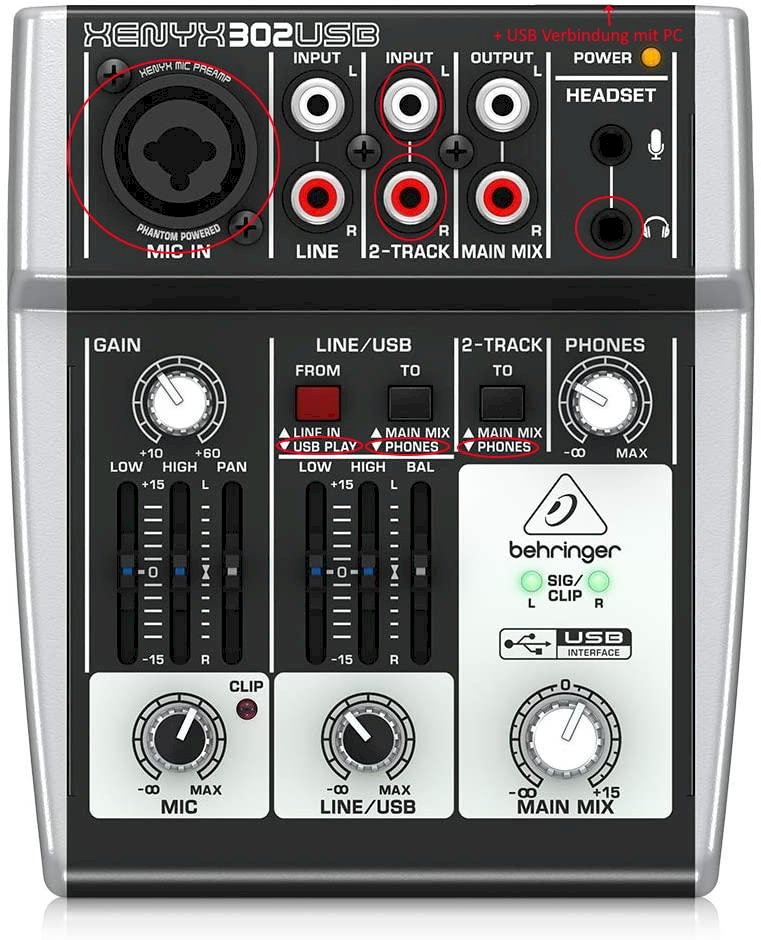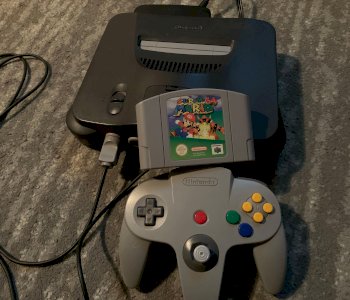Microphone preamp / mixer change makes sense for me?
So I currently have the https://smile.amazon.de/gp/product/B005EHILV4/ mixer with which I'm generally satisfied as far as the "outside life" is concerned.
But since I'm an audio noob, I don't understand a lot.
So this mixer can have a maximum of 16 bit and 48kHz based on the XLR microphone via USB output / input and the mixer has a phantom power of (only) 15V.
First a few little things that I don't quite understand.
24 bit are better than 16 bit and 48kHz are better than 44.1kHz e.g. That is clear to me.
48V phantom power are also better for my https://www.thomann.de/...at2035.htm as far as I've read.
All of this confuses me a bit after I only stream the microphone for Twitch and use things like Discord.
With Twitch a maximum audio bit rate of 320kb / s is possible and a maximum of 48kHz based on OBS. If I understand correctly, the former is very little for it, right?
So the question is how much sense that would make for me if I could turn bit and Hz higher? Would that be compressed too much by OBS, so that it is rather disadvantageous?
48V instead of 15V would make sense as I understand it, right?
Did I understand correctly that the latter means that the microphone picks up less background noise and more the voice, or is that related to something else? Probably also more beautiful? That would be worth gold for me in terms of the background noise.

Have marked what is connected / activated.
The microphone and headset are self-explanatory.
With 2-Track I connected my gaming monitor (from PS4) and the mixer itself is connected to the PC via USB, which functions as an input and output. So I also hear the entire PC audio.
The sound of the PS4 arrives on the PC in OBS via the Elgato, so I only run 2-Track over the headphones so that I can hear the PS4 myself.
Of course, I also hear myself talking on the mixer, which is very helpful with my headphones and in general.
If it makes sense for my use in terms of better sound quality, I would like to buy a better mixer that can 48V 24bit and more Hz and does not cost more than around 100 euro. Of course I want to be able to operate everything with it as with the current mixer.
As I said, is it still questionable for me whether all of this would make a noticeable difference for my project?
I just don't know which mixer is right for my project.
I would be happy if someone would recommend one or more mixers for this, unless it is better in the end I stick with the current one.
Could the microphone be operated by another device with 48V, which can then be connected / looped through to my current mixer via XLR?
Or would you break the microphone because you are exceeding the voltage allowed for the microphone? Would there even be a suitable device for it to work in connection?
Seriously, I've never heard of 15V phantom power. What's that good for?
My only advice would be to get the better right of withdrawal blender and try it out. For a semi-professional environment, you will likely hear little difference. Then you can send the part back in an emergency.
Ah, here:
The AT2035 can be operated with phantom power from 11 to 52 V.
That means that the 15V is enough.
The higher sampling rates are also at the expense of the CPU. Is always a compromise.
https://smile.amazon.de/Behringer-PS400-Micropower-Phantomspeisungs-Adapter/dp/B000FG795I/
I just came across the first review on this device.
Apparently 48V are then used and the 15V are ignored.
So I seem to have misunderstood it when you do it that way.
So it seems to be working right?
What exactly are the advantages of 48V instead of 15V for a condenser microphone which can actually do both? I'm still unsure of what exactly this is related to.
Edit: I read something about it getting more dynamic by whatever that means.
"Since a fixed value is given for Piezos, one can assume that there are no large reserves and that it is quickly destroyed. With microphones that allow a value of" from - to ", things look different there with more voltage a higher headroom is available. You can feed a (condenser) microphone with less voltage than 48V, but then the signal is quieter (and less dynamic?). "
I'll buy the device in question for more tension. I already think that there will be a qualitative difference between 15V and 48V.
Nothing is lost for the money, unless I shoot my microphone with it. 😄
I'll let you know what difference that made next week after the test, in case I don't forget.
Ok cool I have a Scarlett interface and do the equalizer processing on the PC. For that I have a microphone without phantom power, because the band was still lying around. Funzt somehow.
Yes the Scarlett interfaces seem very popular.
Unfortunately, they don't work for me the way I want / have to do it all.
It always depends on what you are doing with these things and how perfectionist you are.
I just want in the case that everything is as good as possible, or especially the background noise of my new microphone, I want to reduce a bit, or also push it qualitatively. Let's see if that helps.
Behringer is just not high-end. But price / performance is just great. I made some nice recordings with the much older "podcast studio". They were kids who sang on karaoke tracks. If that doesn't go out live, but is post-processed, that's okay.
For livepodcast there's currently something chic from Zoom.
Yes, I like to believe you. If you have enough instinct, you can definitely improve it a lot.
It is possible, but my understanding is too little to moderately improve my microphone software in advance. For me it is only relevant for live talk.
I currently (only) run a compressor at OBS, which is great. It works wonders.
With the microphone at the time, I somehow managed to enhance the whole thing with an equalizer in OBS. With the current microphone, however, this is not necessary in comparison, I think. So I'm more of a hardware fixture.
In my opinion, noise suppression or the like can be forgotten for this microphone anyway. Falsifies the voice too much into the negative.
I'm thinking about a new mic.
But I also think that a certain "own sound" and imperfection has its charm. Lo-Fi is just closer.
Probably a matter of taste, but I can somehow understand yes.
I know that from myself that I'm petty in relation to myself in the context. I don't know how it is with others.
In relation to others, they should be understandable to one. There are some people with a microphone that is so bad it is hard to hear. That just sucks. Probably bad headsets mostly.
Otherwise, I have nothing against an original sound or imperfections in relation to others.
I once had a teammate / interlocutor who got a new microphone and that was so incredibly clean and clear. Nearly perfect.
For me, that's the goal.
If I remember correctly it had a USB Auna microphone. I'm not sure if he has changed anything else with the software.
For real 48 V voltage for condenser microphones I would use larger versions like 1202
Then there's Soundcraft or Yamaha Mixer
Audio interface maybe
I just tested the microphone with the 48V instead of the 15V.
My know-how is too little to understand all of this 100% and I'm not sure whether everything makes sense as I say it.
So in the first moment without changing anything except the tension it sounded very similar at first. Maybe a little better with the 48V.
Well then I activated the compressor in the OBS, which is tuned to the 15V. That's when I noticed that it didn't go with the 48V. Means I got a little louder with it. So I adjusted the gain on the mixer so that it matches the compressor again.
The problem then was that I was apparently louder, but my voice basically lacked the gain. Like if I sat too far from the microphone.
In the end, I increased the gain slightly so that I easily got over this 15V compressor and then adjusted the compressor afterwards. In addition, I'm now sitting closer to the microphone as before. As a result, the whole thing now sounds better than with the 15V. The background noise has also become less. Maybe also because of the 48V, but also because I went down a bit with the gain in comparison.
With the 15V I almost certainly couldn't have done that without it sounding worse.
So funny way it sounds better with 15V when I sit further away from the microphone and with the 48V it sounds better when I sit closer.
The other thing that confuses me is that you can also set 12V with the 48V amplifier… But when I do that, it's a very big difference. So much more extreme than with the 15V on the mixer itself. Probably the hardware just doesn't get along well. Otherwise it wouldn't make any sense I guess.
Well in the end after a lot of testing it is now much better with the 48V in comparison.
Would probably make a difference again if you took a mixer that can handle the 48V without having to add an additional amplifier in between.
I'm happy with it now.
I found this mixer which probably meets all of my ideas and would work for my project, right?
https://www.amazon.de/...00I0Q8MYW/
The thing is, it's pretty big and pretty expensive.
I will remember / save it for the future, if there's no more suitable one.
Currently using this device between the microphone and the Behringer 302USB.
https://smile.amazon.de/Behringer-PS400-Micropower-Phantomspeisungs-Adapter/dp/B000FG795I/
Works in itself, but certainly not a high-end solution.
The Yamaha mixer suggestion was definitely very helpful if you can do everything with it exactly as with the 302USB, just higher quality overall?


